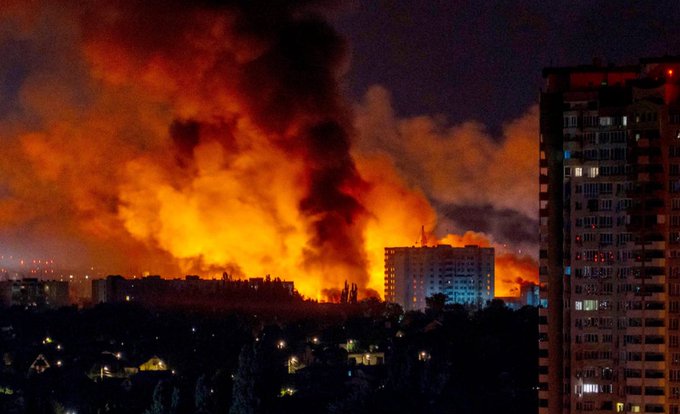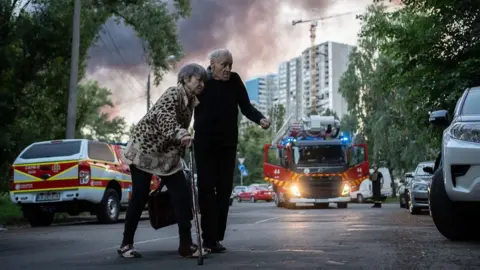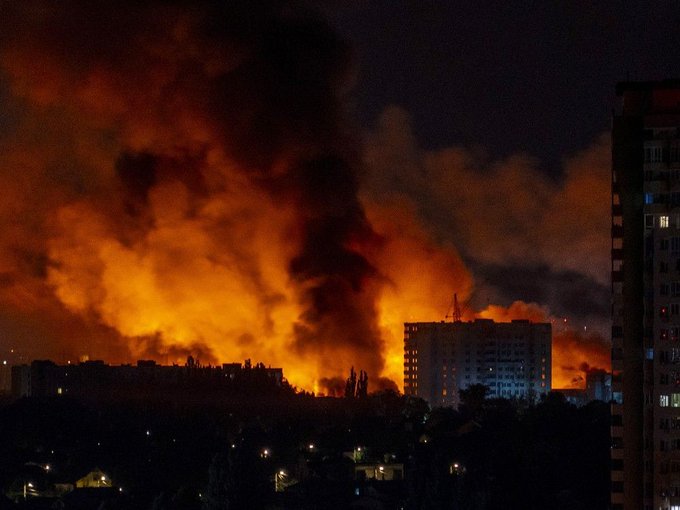Unprecedented Assault
In the early hours of July 4, 2025, Ukraine endured the largest aerial assault since the onset of Russia’s full-scale invasion in 2022. Russian forces launched a staggering 550 drones and missiles in a coordinated overnight attack, with the capital city of Kyiv bearing the brunt of the onslaught. The Ukrainian Air Force described the barrage as the most intense single attack to date, overwhelming air defenses and leaving a trail of destruction across multiple regions.

The Night of Terror in Kyiv
The first air raid sirens sounded before nightfall, sending Kyiv’s residents scrambling for shelter. Many sought refuge in the city’s metro stations, which have become makeshift sanctuaries during frequent air raids. By midnight, the platforms and corridors were packed with people, their belongings hastily gathered for another sleepless night underground.
The relentless buzzing of Iranian-made Shahed drones filled the air, punctuated by explosions as Ukrainian air defenses attempted to intercept the incoming threats. Despite these efforts, the scale of the attack meant that many drones and missiles penetrated the city’s defenses. Debris rained down on at least 33 locations, igniting fires and causing widespread panic.

Human Toll and Infrastructure Damage
Kyiv’s Mayor, Vitali Klitschko, reported that at least 23 people were injured, with 14 hospitalized. Tragically, at least one fatality was confirmed as rescue operations continued into the morning. The attacks damaged apartment buildings, businesses, a school, a medical facility, railway lines, and other civilian infrastructure in at least eight districts of the city. Fires blazed across neighborhoods, and the air became thick with smoke and toxic fumes, making it hazardous even in areas far from the direct impact sites.
Residents described the experience as a “nightmare come to life.” One survivor recounted how the lights went out and glass shattered around her as her building shook from the blasts. The psychological toll of repeated attacks is mounting, with many expressing exhaustion and fear after more than three years of war.
Wider Impact Across Ukraine
While Kyiv was the primary target, the assault extended to other regions, including Dnipropetrovsk, Sumy, Kharkiv, and Chernihiv. Ukrainian President Volodymyr Zelenskyy condemned the attack as “cynical” and “deliberately massive,” emphasizing that Russia’s strategy is to terrorize civilians and break the country’s resolve.
Ukrainian air defenses managed to shoot down a significant number of incoming threats—reports indicate that 270 targets, including two cruise missiles, were intercepted. However, the sheer volume of drones and missiles meant that many still reached their targets, causing extensive damage and casualties.
Diplomatic Stalemate: Trump and Putin’s Fruitless Dialogue
The record-breaking assault came just hours after a high-profile phone call between U.S. President Donald Trump and Russian President Vladimir Putin. Hopes for diplomatic progress were quickly dashed. President Trump, speaking to reporters, expressed deep disappointment, stating, “I didn’t make any progress with him today at all.” He lamented that Putin showed no willingness to halt the war, despite repeated calls for a ceasefire from the United States and its allies.
The Kremlin, for its part, reiterated its commitment to achieving its objectives in Ukraine, with Putin’s advisers insisting that Russia would not back down and would continue to address what it calls the “root causes” of the conflict. These include demands for Ukraine to abandon its NATO ambitions and recognize Russian territorial gains—conditions Kyiv and the West have categorically rejected.
Escalation Amidst Waning Western Support
The timing of the attack is significant. It followed the U.S. decision to pause shipments of critical air defense systems and precision-guided munitions to Ukraine, a move that Ukrainian officials warned would weaken their ability to defend against such large-scale assaults. The Russian offensive appears calibrated to exploit this moment of vulnerability, intensifying pressure on both the Ukrainian military and civilian population.
Conclusion
The record drone and missile attack on Kyiv and other Ukrainian regions marks a grim escalation in the ongoing conflict. As diplomatic efforts stall and Western support faces new challenges, Ukraine finds itself bracing for further violence. The events of July 4 serve as a stark reminder of the war’s human cost and the formidable obstacles to peace.

